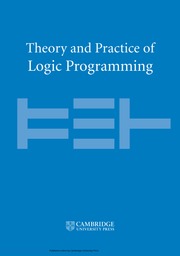Article contents
How to Build Your Own ASP-based System?!
Published online by Cambridge University Press: 13 December 2021
Abstract
Answer Set Programming, or ASP for short, has become a popular and sophisticated approach to declarative problem solving. Its popularity is due to its attractive modeling-grounding-solving workflow that provides an easy approach to problem solving, even for laypersons outside computer science. However, in contrast to ASP’s ease of use, the high degree of sophistication of the underlying technology makes it even hard for ASP experts to put ideas into practice whenever this involves modifying ASP’s machinery. For addressing this issue, this tutorial aims at enabling users to build their own ASP-based systems. More precisely, we show how the ASP system clingo can be used for extending ASP and for implementing customized special-purpose systems. To this end, we propose two alternatives. We begin with a traditional AI technique and show how metaprogramming can be used for extending ASP. This is a rather light approach that relies on clingo’s reification feature to use ASP itself for expressing new functionalities. The second part of this tutorial uses traditional programming (in Python) for manipulating clingo via its application programming interface. This approach allows for changing and controlling the entire model-ground-solve workflow of ASP. Central to this is clingo’s new Application class that allows us to draw on clingo’s infrastructure by customizing processes similar to the one in clingo. For instance, we may apply manipulations to programs’ abstract syntax trees, control various forms of multi-shot solving, and set up theory propagators for foreign inferences. A cross-sectional structure, spanning meta as well as application programming, is clingo’s intermediate format, aspif, that specifies the interface among the underlying grounder and solver. We illustrate the aforementioned concepts and techniques throughout this tutorial by means of examples and several nontrivial case studies. In particular, we show how clingo can be extended by difference constraints and how guess-and-check programming can be implemented with both meta and application programming.
Information
- Type
- Survey Article
- Information
- Creative Commons
- This is an Open Access article, distributed under the terms of the Creative Commons Attribution licence (http://creativecommons.org/licenses/by/4.0/), which permits unrestricted re-use, distribution, and reproduction, provided the original article is properly cited.
- Copyright
- © The Author(s), 2021. Published by Cambridge University Press
Footnotes
This work was partially funded by DFG grants SCHA 550/11 and 15. We are grateful to the anonymous reviewers and in particular to Mirosław Truszczyński for his relentless efforts to improve the presentation of our paper – thank you so much!
References
- 27
- Cited by


